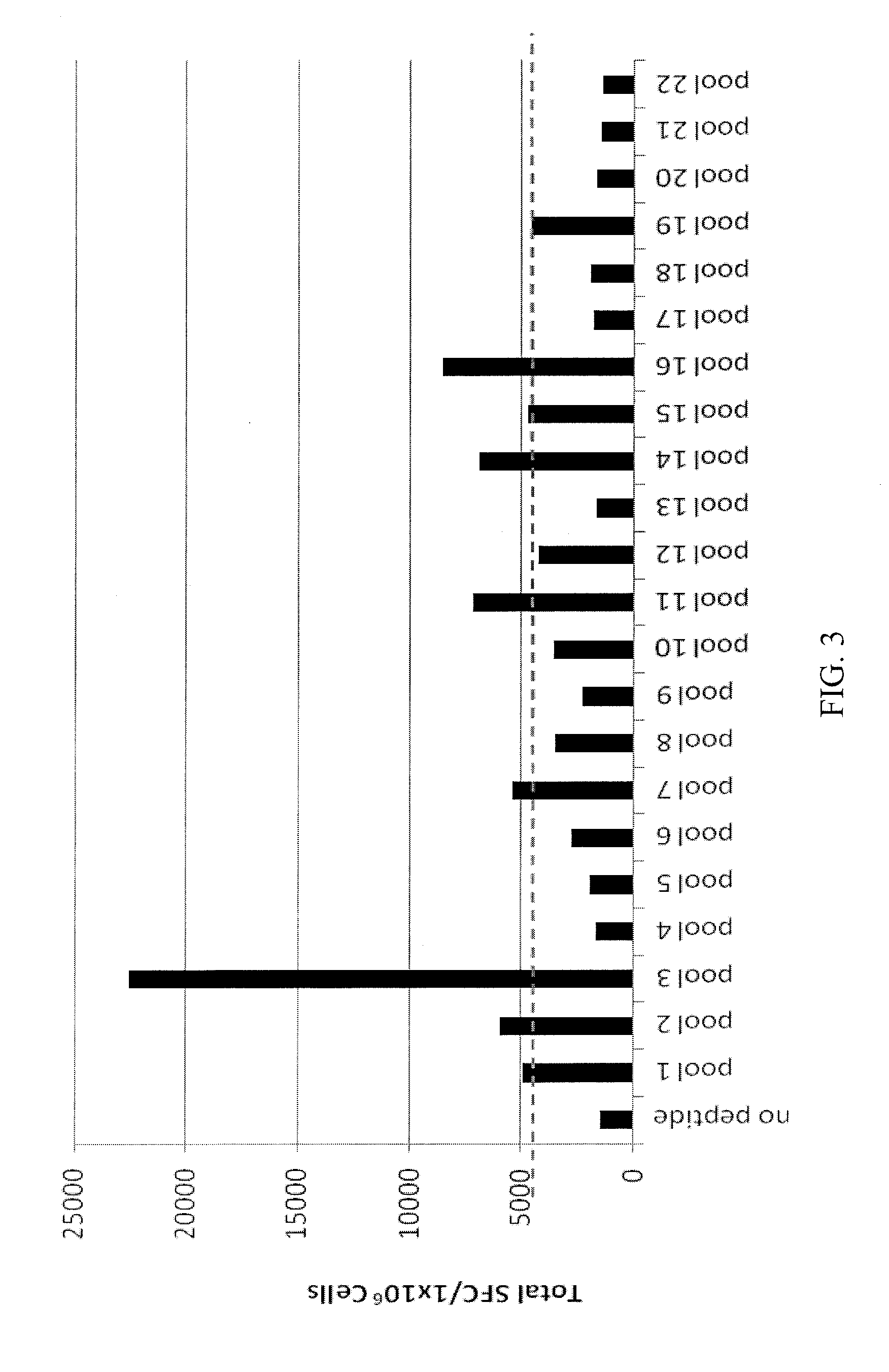Pseudomonas exotoxin A with less immunogenic T cell and/or B cell epitopes
a technology of t cell and b cell epitope, which is applied in the direction of drug composition, fusion of specific cell targeting, peptide/protein ingredients, etc., can solve the problems of reducing the effectiveness of pe for treating disease, e.g., cancer, and being highly immunogenic to pe, so as to reduce the level of antibodies
- Summary
- Abstract
- Description
- Claims
- Application Information
AI Technical Summary
Benefits of technology
Problems solved by technology
Method used
Image
Examples
example 1
[0144]This example demonstrates the frequency of HLA class 2 alleles in a naïve donor cohort as compared to that of the world population.
[0145]Peripheral blood mononuclear cells (PBMC) were isolated from 65 healthy donors obtained from the NIH blood bank and 50 patients undergoing treatment with immunotoxin at the NCI. PBMC were isolated from buffy coats by Ficoll density centrifugation. The HLA class I and class II haplotypes of the PBMC of patients and healthy donors were identified using a PCR-SSP / SSO-based tissue typing kit. PBMC were then frozen in heat-inactivated human AB serum and standard freezing media and stored in liquid nitrogen until used.
[0146]A cohort of 65 healthy donors was studied to provide information on the number and frequency of HLA DR allotypes expressed in the world population. Analysis of the allotypes expressed in the naïve donor cohort was compared with the world population (Middleton, D. et al., New Allele Frequency Database: allelefrequencies.net, Tiss...
example 2
[0148]This example demonstrates the preparation of a peptide library to be used to stimulate T cells.
[0149]To determine the immunogenicity of the toxin moiety, a library of 111 peptides was designed, spanning the entire sequence of PE38. The peptides each had a size of 15 amino acids and overlapped by 12 amino acids with the exception of peptide SEQ ID NOs: 31 and 32, which overlapped by 11 amino acids. The peptides were synthesized at >95% purity as determined by high performance liquid chromatography (HPLC) (American Peptide Co. Inc., Sunnyvale, Calif.). The lyophilized synthetic peptides were dissolved in dimethyl sulfoxide (DMSO) to make 10 μM stock solutions.
The peptides were grouped into 22 pools as shown in Table 2. Table 2 shows the sequences, SEQ ID NOs, and pool numbers of the peptides used for epitope mapping.
[0150]
TABLE 2SEQIDNO:Sequencepool 31PEGGSLAALTAHQAC 1 32SLAALTAHQACHLPL 1 33ALTAHQACHLPLETF 1 34AHQACHLPLETFTRH 1 35ACHLPLETFTRHRQP 1 36LPLETFTRHRQPRGW 2 37ETFTRHRQP...
example 3
[0151]This example demonstrates that in vitro expansion of naïve donor T cells improves the sensitivity and response level of the T cells to peptide pools.
[0152]In order to mimic the immune response that occurs in patients following treatment and to overcome the low sensitivity and unresponsiveness in naïve donor samples in the short term assay, a 17 day in vitro expansion step was employed to expand the specific T cell population (Oseroff et al., J. Immunol., 185(2): 943-55 (2010)). The cells were incubated for 14-17 days after stimulation with immunotoxin. For stimulation, immunotoxin LMB9 or B3 (dsFv)-PE38 targeting LeY (Brinkmann et al., Proc. Natl. Acad. Sci. USA, 90(16): 7538-42 (1993)), an antigen not present on human immune cells, was used. On day 14-17, the cells were harvested and assayed by an interleukin (IL)-2 ELISpot assay using the 22 peptide pools of Table 2. The addition of the in vitro expansion step improved the sensitivity and response level of the ELISpot assay ...
PUM
| Property | Measurement | Unit |
|---|---|---|
| temperatures | aaaaa | aaaaa |
| temperature | aaaaa | aaaaa |
| volume | aaaaa | aaaaa |
Abstract
Description
Claims
Application Information
 Login to View More
Login to View More - R&D
- Intellectual Property
- Life Sciences
- Materials
- Tech Scout
- Unparalleled Data Quality
- Higher Quality Content
- 60% Fewer Hallucinations
Browse by: Latest US Patents, China's latest patents, Technical Efficacy Thesaurus, Application Domain, Technology Topic, Popular Technical Reports.
© 2025 PatSnap. All rights reserved.Legal|Privacy policy|Modern Slavery Act Transparency Statement|Sitemap|About US| Contact US: help@patsnap.com



